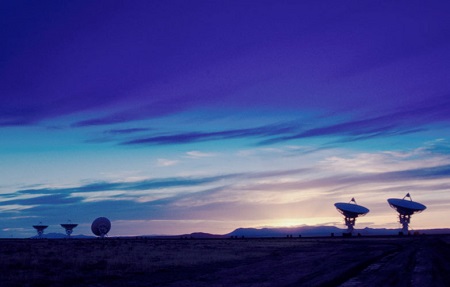
 The
findings, which were presented Tuesday (Dec. 4) here at the annual meeting
of the American Geophysical Union in San Francisco, could add to the
arsenal the international community uses to detect such rogue tests.
The
findings, which were presented Tuesday (Dec. 4) here at the annual meeting
of the American Geophysical Union in San Francisco, could add to the
arsenal the international community uses to detect such rogue tests.
"Both
methods are quite effective at finding ionospheric disturbance and finding the
underlying source of this disturbance," said Joseph Helmboldt, a radio
astronomer at the U.S. Naval Research Academy who conducted the research.
After
the Comprehensive Nuclear Test Ban Treaty was adopted by the United Nations in
1996, all but three countries — North Korea, India and Pakistan — signed it.
Yet many experts believe countries such as North Korea and Iran are continuing
to secretly develop a nuclear arsenal.
To
detect rogue nuclear tests, the International Monitoring System deploys a
network of more than 250 locations with sensors that detect shock waves from
underground blasts, radioactive particles in the atmosphere, and ultra-low frequency
sound waves caused by the explosions. (Regarding weapons tests, North Korea has
said it will launch a long-range missile this month, drawing condemnation from
U.S. officials who say they view the act a thinly veiled ballistic missile
test.)
In
2009, North Korea conducted a nuclear test a few hundred miles north
of their capitol, Pyongyang. At that time, Dorota Grejner-Brzezinska of Ohio
State University and her colleagues were developing ways to improve GPS and
noticed that waves from the upper atmosphere were disrupting signals received
by GPS satellites. [Satellites Gallery: Science From Above]
When
they went back to their calculations, they realized the "noise"
actually came from the nuclear test. Because underground nuclear fission tests
create powerful forces that rock the Earth's crust, waves form at the surface
that then travel into the upper atmosphere, which Grejner-Brzezinska had
detected.
Her
team then developed an algorithm to pick out such nuclear tests and looked at
historical GPS data to see if they could pick out nuclear tests from the past.
They could.
She
then contacted researchers at the Very Large Array, a set of 27 iconic
radio telescopes placed in the remote New Mexico desert. They pored over
their historical records and found they could detect an underground nuclear
test that the United States had conducted at Hunters Trophy, Utah, in 1992,
Helmboldt said. It turns out, those disruptions in the atmosphere triggered by
the nuclear tests actually sort of deform radio waves.
The
new techniques haven't been tested to see whether they can distinguish nuclear
tests from small earthquakes or mining blasts, he said.
While
the new techniques won't replace the existing network, they could eventually
complement it, he said.
Since
satellites span the globe, they may be able to detect blasts that occur in
areas sparsely covered by existing seismology sensors. And if governments
reduce how much nuclear blasts shake the Earth, the explosions would probably
be even more noticeable by GPS or radio telescopes looking for atmospheric
disturbances, Helmboldt said.
"If
you were able to devise a way to mitigate how much energy goes into the Earth's
crust, the energy has to go somewhere and you would see it go up into the
atmosphere," he said.

 Previous page
Previous page Back to top
Back to top







